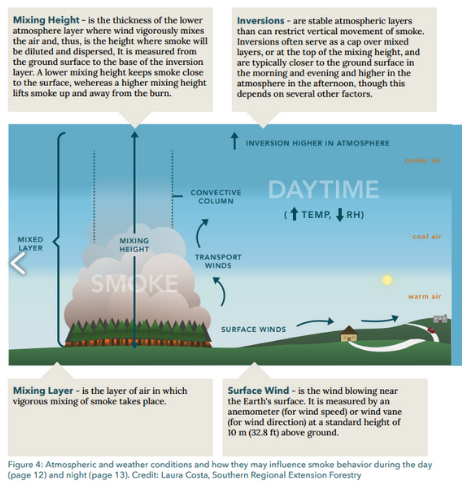Smoke Management: Planning Resources

By: Elliot Nauert
A recent video by the Southern Fire Exchange describes the public health concerns of smoke, reminding us why it is important to take smoke management seriously. In an earlier post, we shared some training resources to build the foundations of smoke management knowledge. That knowledge is first applied to prescribed burning during the planning stage, before your fire is even on the ground and before your smoke is in the air. Here are some resources to help in that planning process:
- Southern Fire Exchange Fact Sheet: Basic Smoke Management Practices for Prescribed Burning
- This is a quick overview of the six main practices to take before, during, and after your burn. Here are the ones listed for doing before burning:
- Use smoke modeling tools like the ones listed below to develop a smoke management plan that accounts for expected smoke movement and impacts to smoke sensitive areas.
- As you get close to a potential burn window, monitor the weather and air quality conditions and forecasts.
- Record the weather and air quality conditions and forecasts.
- Notify authorities and citizens of the potential for any anticipated air quality impacts from your smoke.
- In your burn plan, include any emission reduction techniques you can like burning just before forecasted rain that will help extinguish any residual burning and smoke.
- Coordinate with other burn managers in your area to distribute the timing of your burns and minimize the amount of smoke output on any single day.
- Smoke Management Guidebook for Prescribed Burning in the Southern Region
- This guide to smoke management goes into more detail and is designed for landowners in the South.
- EPA’s AirNow Website
- Get detailed air quality conditions and forecasts for your area. If air quality is poor you should try to burn at a later date.
- Smoke Modeling Tools
- Run smoke simulations that will show where your smoke is expected to travel. This helps determine appropriate wind and atmospheric conditions for your burn prescription, and will help you know when the conditions are right to conduct your burn.
- Simple Smoke Screening Tool
- VSmoke-Web
Questions? Contact us at wildlandfire@ncsu.edu.